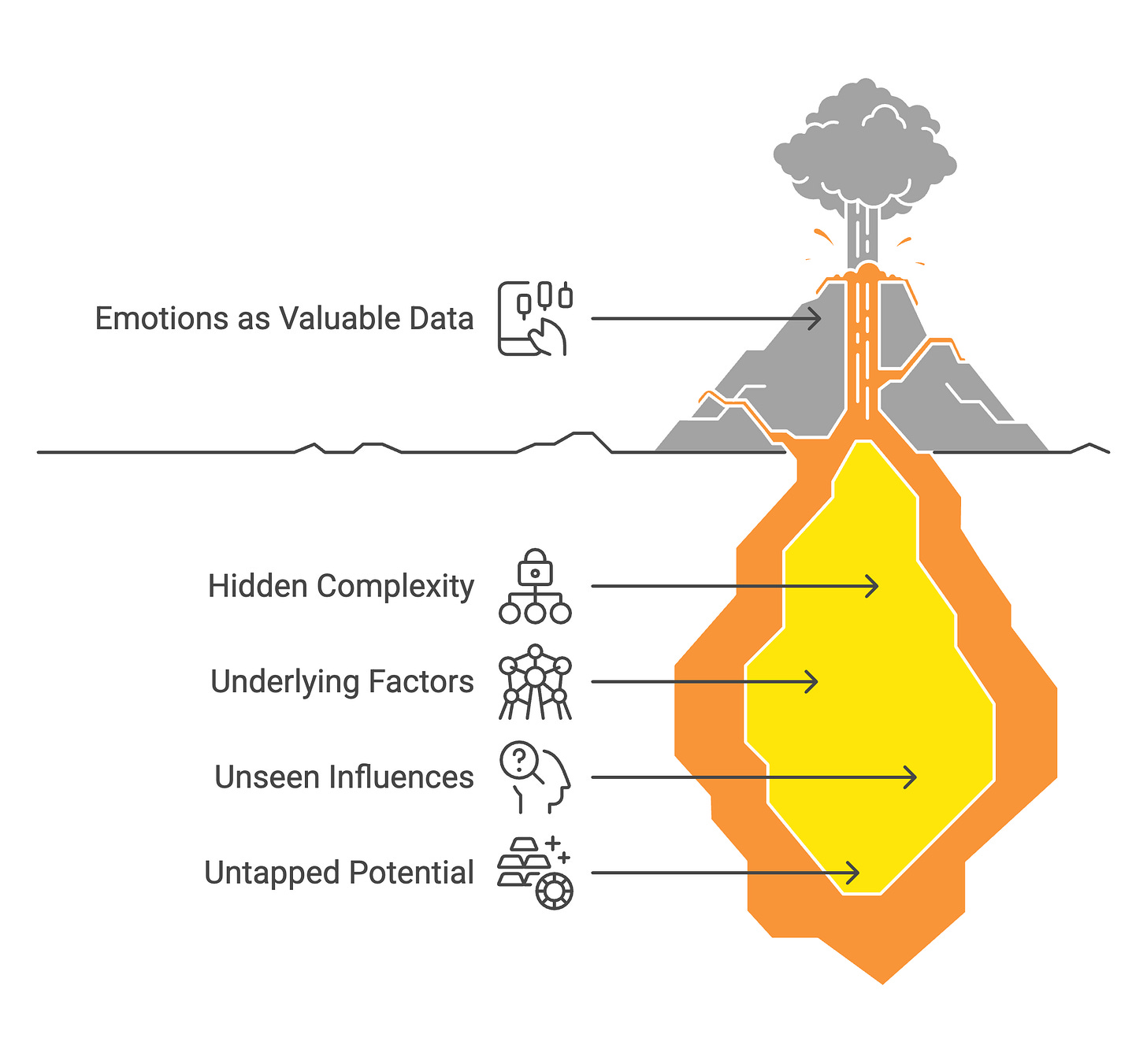Emotions. They're Your Most Valuable Data.
A system to help you track your emotions
Last Wednesday, I sat at my desk staring at a spreadsheet of client deadlines—and suddenly felt an all-too-familiar tightening in my chest.
I realized I had no idea what I was actually feeling: Was it anxiety? Resentment? Exhaustion?
Without clarity, I just pressed on, making decisions in the dark.
If you’ve ever navigated your day blind to your own emotions, you know how that ends: confusion, stalled progress, and persistent stress.
Below is a three-pillar framework—Observe, Intervene, Connect—that transforms emotional roadblocks into actionable strategies.
Each pillar opens with a clear why (grounded in research) and ends with simple steps you can take today.
Observe Your Inner Landscape
Why it works: Simply noticing and labeling emotions engages the right ventrolateral prefrontal cortex, which in turn dampens amygdala reactivity—turning down your internal “alarm bell” rather than feeding it unchecked anxiety.
Track Your Emotions.
Begin by jotting down how you feel at set points each day. Rate your mood on a 1–10 scale, note one trigger, and record one context (e.g., “3 PM, after client call, felt overwhelmed”). Over time, patterns emerge, revealing what drains or boosts your energy.Focus on One Feeling at a Time.
When the ups and downs blur together, pick the single most intense emotion and explore it for two minutes. Ask: “Where do I feel this in my body? What thought accompanies it?” This micro‑practice mirrors focused-attention exercises shown to improve clarity and reduce cognitive overload.Schedule “Emotion Check‑Ins.”
Block 5 minutes in your calendar—just as you would for a meeting—and ask yourself, “What am I feeling right now?” No analysis, no judgment—just awareness. Regular check‑ins cultivate emotional literacy, the essential first step toward mastery.
Intervene Strategically
Why it works: Once you’ve mapped your emotional terrain, targeted interventions—professional support or self‑administered tools—prevent overwhelm from spiraling.
Seek Professional Help When Needed.
If negative emotions feel unrelenting or you’re experiencing chronic “life sucks” days, therapy isn’t a luxury; it’s a resilience builder. Research shows that working with a trained counselor accelerates coping‑skill development and long‑term well‑being.Build Your Personalized Emotional Toolkit.
Create a menu of go‑to strategies for different states:Breathing Exercises for acute anxiety.
Expressive Journaling to offload ruminative thoughts—studies find that just three days of expressive writing can significantly lower depressive symptoms six months later.
Physical Activity (even a 10‑minute walk) to trigger endorphin release.
Grounded Social Connection (a quick call with a friend) to reframe perspectives.
Reawaken When You’re Numb.
If life feels flat, deliberately seek an experience that evokes strong emotion: watch a moving documentary, immerse yourself in an evocative playlist, or try a new adventure sport. These jolts reconnect you with your emotional core and remind you what “alive” feels like.
Connect & Recharge
Why it works: Sharing vulnerability and prioritizing replenishment deepen social bonds and sustain energy—two critical ingredients for long‑term fulfillment.
Share Your Journey.
Vulnerability builds trust. Whether it’s a brief post on Substack, a story shared with a peer group, or a discussion in a mastermind, opening up about your emotional wins and setbacks invites support—and often inspires others to do the same.Prioritize Soul‑Nourishing Activities.
List three go‑to practices that fill your cup—nature walks, painting, or quality time with loved ones—and schedule them weekly. Consistent self‑care stabilizes your baseline mood and strengthens resilience against stress.Engage Your Circle.
Invite a colleague or friend to join you in the weekly check‑in practice. Accountability not only keeps you honest but transforms a solitary habit into a shared bond.
Take Action Today
Set up one emotion check‑in in your calendar for tomorrow at 10 AM.
Download or create a simple tracking sheet—date, time, emotion, context—and fill it out at that check‑in.
Share one observation (“I notice I dip below a 4 after 4 PM”) in the comments below or with a trusted friend.
By moving from passive feeling to active observation and intervention, you reclaim choice—and unlock not just greater wealth, but true life satisfaction. Choose your first step now, and let your emotional data guide you forward.
👉 If you enjoy reading this post, feel free to share it with friends! Or feel free to click the ❤️ button on this post so more people can discover it on Substack




I really enjoyed thsi post -- especially the part on observing your inner emotions.
Have you ever felt sad but had no idea why? I talked to someone yesterday where this was the case and wondered what you'd do with a similar emotion for no apparent reason.
Thank you for writing this!